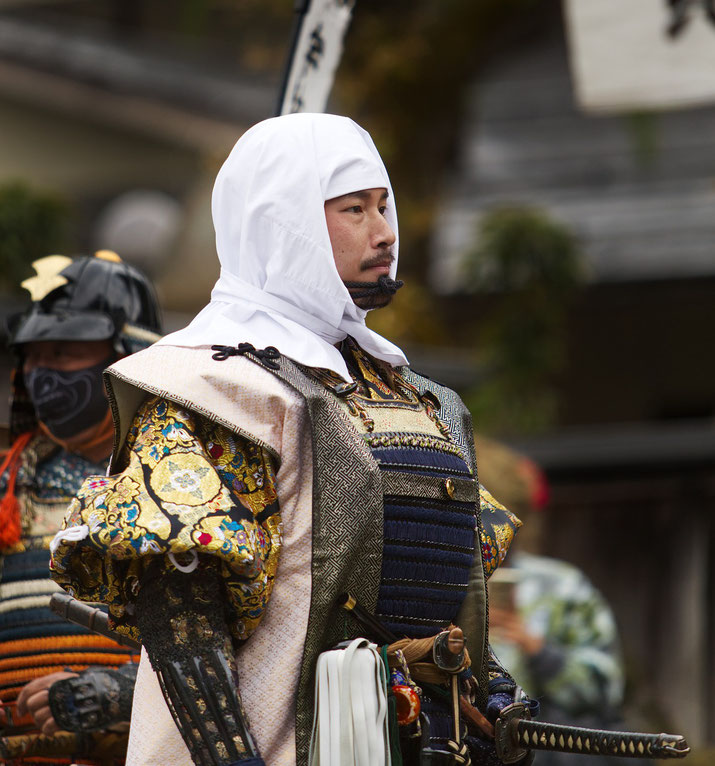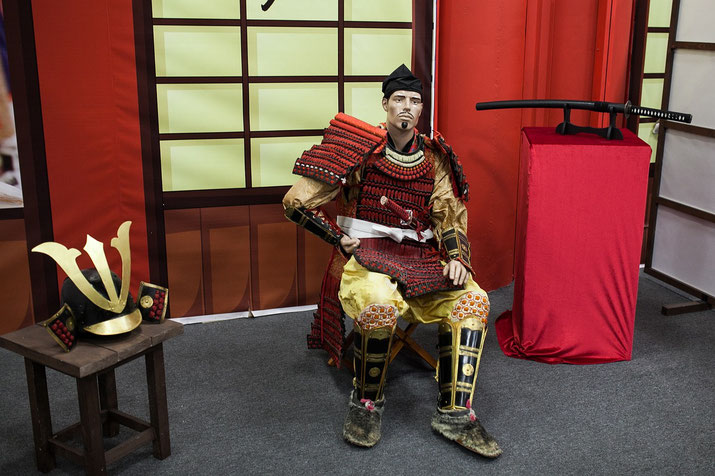How the Tokugawa Shogunate came to power in feudal Japan

From AD 1467 to 1615, Japan experienced a long period of civil war called the Sengoku Jidai, which means 'The Warring States' period.
During this period, various daimyo engaged in combat with their substantial samurai forces, vying to be named shogun (supreme military commander) by the emperor of Japan.
If a shogun was not powerful enough to fight off his rivals, it encouraged others to attempt to take control as well.
Notably, three daimyo emerged victorious in these power struggles, each progressively gaining control over more extensive areas of the nation.
These three were known as the 'unifiers of Japan' and are examined in more detail below.
Oda Nobunaga: The first unifier
Oda Nobunaga originated from the Owari region in Japan and was known as a merciless warlord who readily embraced innovative tactics to gain an advantage over his rivals.
Most famously, he adopted Western gunpowder weapons which had appeared in the country following trading missions from the Portuguese in 1543.
As a result, he introduced Western-style military tactics in his army, including the use of massed arquebus fire.
One of Oda Nobunaga’s early defining victories came at the Battle of Okehazama in 1560 against Imagawa Yoshimoto.
Despite being heavily outnumbered, (having only 2,000-3,000 troops against Imagawa Yoshimoto's 25,000), Nobunaga executed a surprise attack on the enemy camp during a rainstorm.
Thanks to the weather and the terrain, he caught them off guard, leading to Yoshimoto's defeat and death.
This unexpected victory significantly boosted Nobunaga's reputation across Japan.
Using his growing power, Oda Nobunaga seized control of the imperial capital of Kyoto in 1568 by supporting Ashikaga Yoshiaki's bid to become shogun.
Yoshiaki had sought revenge against the Miyoshi clan, who controlled Kyoto after his brother's death and Nobunaga saw this as an opportunity to advance his goal of unifying Japan.
As a result, he gathered his forces, defeated the Rokkaku clan en route, and entered Kyoto in November 1568.
There, he overthrew the Miyoshi clan's puppet shogun, Ashikaga Yoshihide, and installed Yoshiaki as the 15th shogun
Also, throughout his rise to power, Nobunaga struggled against the political power of some Buddhist monasteries that had their own 'warrior monks', who resisted him.
On some occasions, Nobunaga attacked these religious buildings and slaughtered the monks in them, which shocked the rest of Japan.
The most famous of which was the massacre of the monks at Mount Hiei.
Nobunaga achieved his greatest success after winning the Battle of Nagashino in 1575 thanks to the use of western firearms.
This led to the eventual destruction of the Takeda clan in 1582 following another defeat at the Battle of Tenmokuzan.
Their last leader, Takeda Katsuyori, who had long resisted the forces of Oda Nobunaga, committed suicide.
However, his brutal reputation led to his downfall, as one of his own military commanders, Akechi Mitsuhide, betrayed him.
On June 21, 1582, Nobunaga was caught off guard with only a small retinue and, after realizing the hopelessness of his situation, retreated to an inner room of the Honnō-ji Temple.
Rather than go in and attack him, Akechi Mitsuhide ordered the temple to be burnt down with Oda inside.
As the building was being set ablaze, Oda was killed, commit suicide in a ritual known as seppuku.
Toyotomi Hideyoshi: The second unifier
The next 'unifier of Japan' arose after Oda Nobunaga and was named Toyotomi Hideyoshi.
Famously, Hideyoshi did not come from a samurai family. Instead, he was of peasant origin, which makes his rise to power particularly remarkable.
Hideyoshi had actually served under Oda Nobunaga and had been promoted due to his gift for military matters.
By the time of Nobunaga's suicide, Hideyoshi was one of the most respected generals in his army.
After Oda Nobunaga’s death, Toyotomi Hideyoshi swiftly avenged him by defeating Akechi Mitsuhide at the Battle of Yamazaki in 1582.
This success made it obvious that he was Nobunaga’s successor and, by 1590, had become the most powerful daimyo in Japan.
Hideyoshi established his capital at Osaka and planned to expand Japanese power internationally by invading the Korean peninsula.
The first invasion in 1592 was initially quite successful, with Japanese forces advancing far into Korean territory.
However, they were eventually repelled by a combination of Korean land forces, with significant assistance from the Chinese Ming Dynasty, and the Korean navy led by Admiral Yi Sun-sin.
The second invasion, which began in 1597, was less successful and was still ongoing at the time of Hideyoshi's death in 1598. It was abandoned soon after.
Hideyoshi's greatest impact on Japanese history is the enforcement of a strict class system that is akin to European feudalism.
In 1588, Hideyoshi enacted the famous ‘Sword Hunt’ (katana-gari), which made it illegal for peasants to carry weapons.
Ultimately, disarming common people was an effective way of solidifying samurai control and reduce the possibility of rebellion.
Tokugawa Ieyasu: The third and final unifier
The greatest and final of the three unifiers was the daimyo of the Mikawa region: Tokugawa Ieyasu.
Ieyasu served as a general in Nobunaga's army and regularly achieved victories on the battlefield.
After Nobunaga's suicide, Ieyasu became a commander in Hideyoshi's forces as well.
Then, when Hideyoshi died in 1598, Ieyasu became the protector of Hideyoshi's son and used him as a way to manipulate his way to power.
Hideyoshi's other generals were angered by this move.
In AD 1600, Hideyoshi's former generals brought their combined armies against Ieyasu at the decisive Battle of Sekigahara.
This is one of the most famous battles in all of Japanese history, with over 200,000 soldiers involved.
However, Tokugawa Ieyasu used clever tactics to defeat his rivals. Following this, Ieyasu established the Tokugawa Shogunate in 1603 when Ieyasu received the title of shogun.
His capital city, Edo (modern-day city of Tokyo) became the new capital of his shogunate, which would last for over 250 years.
However, even after founding his new shogunate, Ieyasu still had to neutralize his remaining enemies.
It was not until 1615 that he removed the final resistance against him when he defeated the last remaining Toyotomi forces at Osaka.
This event is often considered to be the official end of the Sengoku Jidai period.

How the Tokugawa Shogunate controlled the daimyo
The Tokugawa shoguns that followed Ieyasu established a series of strict laws to ensure that no daimyo could challenge their authority.
The Tokugawa shogunate reorganized the land of Japan into over 250 domains, or han, which were controlled by the daimyo who pledged loyalty to the shogun in exchange for their territories.
In fact, each daimyo received a region to govern and a government position that reflected their level of loyalty to the shogunate: the more trustworthy they were, the larger their lands and influence became.
These assignments reinforced the power structure, binding the daimyo to the central government in Edo.
Additionally, the shoguns implemented the Sankin-kōtai policy, which required daimyo to maintain a residence in Edo.
This policy forced the daimyo’s wife and heir to live in Edo, effectively holding them as hostages to ensure the daimyo's obedience.
Every few years, each daimyo was also required to travel to Edo for a personal visit.
The journey was costly, which kept many daimyo from accumulating enough wealth to pose a threat.
By controlling their financial resources and maintaining constant supervision, the Tokugawa shogunate effectively neutralized potential rebellions.
The combination of these policies succeeded in maintaining order for centuries.
No major uprising against the shogunate occurred until the mid-19th century, which showed how effective this rigid system of control was.
What do you need help with?
Download ready-to-use digital learning resources
Copyright © History Skills 2014-2025.
Contact via email
With the exception of links to external sites, some historical sources and extracts from specific publications, all content on this website is copyrighted by History Skills. This content may not be copied, republished or redistributed without written permission from the website creator. Please use the Contact page to obtain relevant permission.







